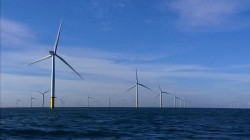HVDC grids to facilitate cross-border energy exchange
In addition to solar, wind power is growing as a source of alternative energy, and is expected to occupy a major portion of the market by mid-century. Wind Europe (former EWEA), which represents the wind industry, reports that wind energy now covers over 11% of Europe’s electricity demand. It estimates an increase to 20% by 2020, 33% by 2030, and 50% by 2050 corresponding to the EU share. This ongoing increase requires an upgrade of the transmission system. Offshore wind farms produce a higher amount of energy compared to those onshore due to strong and steady wind. However, existing offshore wind farms transmit power via high-voltage alternating current (HVAC). The problem is that too much energy is lost in cables when the wind turbines are too far from the mainland. Operators and manufacturers are therefore considering transmission through high-voltage direct current (HVDC), because of the technical advantages it represents in cases of long distances and over a certain level of power. Sintef Energy Research, an international organisation based in Trondheim, Norway, has been working on HVDC solutions to prevent power loss. Salvatore D’Arco, one of the researchers dealing with the issue, explains: “HVAC transmission with cables becomes less preferable or even unfeasible when the distance increases. The (distance) threshold depends on many factors, such as the cable construction or the operating voltage, but typically is in the range of 80-100 km. This is the main reason why HVDC is instead applied for interconnecting Norway with Denmark, or in the planned link between Norway and the United Kingdom.” Sintef researchers, in close collaboration with partners of the EU project BEST PATHS, have developed a “DC lab facility” to simulate offshore multi-terminal HVDC grids (MT-HVDC) and their interaction with wind generators. Thanks to an MT-HVDC mesh grid, if one of the cables fails, the energy is sent to the mainland through an alternative route. The demonstrator of the EU project is made up of three converters, installed in the Norwegian National Smart Grid Laboratory, which are small-scale replicas of real large converters installed in offshore wind farms. In the lab, the researchers study variables in power generation, and identify grid integration issues that can arise in a real system before they occur in an expensive infrastructure. This research can be a benchmark for supergrid projects in Europe. For example, experts are discussing building the so-called North Sea offshore grid, an interconnected network to replace the site-by-site link between the renewable sources and the mainland of 10 countries. “There is a perspective of creating an offshore DC-terminal in the North Sea to facilitate not only the integration of offshore resources but also the power exchange between countries,” D’Arco says. “Energy can be transferred from a country with an excess of production to a country lacking energy or, in general, from a country where the energy cost is lower to a country where this cost is higher.” By Susan Fourtané
Keywords
Countries
Norway



